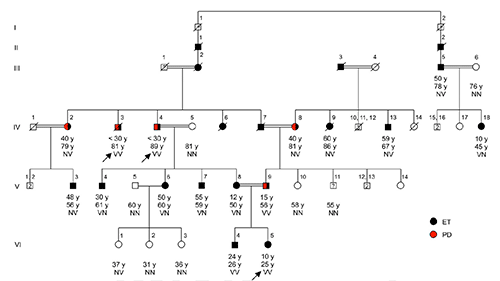Scientists have identified a gene which causes essential tremor and Parkinson disease. They said their study is the first clue that links two common movement disorders and could lead to new treatments.
Essential tremor is the most frequent movement disorder of humans and can be associated with substantial disability. The worldwide prevalence is 0.9%, increasing to more than 4% in elderly populations.
Parkinson disease is the second most common neurodegenerative disorder with a prevalence of 0.3% of the whole population in industrialized countries. In elderly populations, the prevalence may rise as high as 1% in those over 60 years of age to 4% of the population over 80. It is estimated that Parkinson disease affects 7 million people globally.
Clinicians for decades have been perplexed by the observation that some but not all persons with essential tremor develop signs of Parkinson disease, and the relationship between the conditions has not been clear.
Researchers at Bilkent University and the University of Washington, in collaboration with clinicians at Hacettepe and Ankara Universities, studied a remarkable kindred from Central Anatolia.
In the six-generation consanguineous Turkish kindred with both essential tremor and Parkinson disease, the team carried out whole exome sequencing and pedigree analysis.
They identified mitochondrial serine protease HTRA2 as the likely gene responsible for both conditions.
The same mutation had previously been associated with Parkinson characteristics in mouse mutants.
In the Turkish family, inheriting the mutation from one parent (heterozygous) or both parents (homozygous) resulted in essential tremor. However, homozygosity was associated with earlier age at onset of tremor during the teens or twenties, and more severe tremor.
Homozygotes, but not heterozygotes, developed Parkinson signs in the middle age. The disease is caused by the loss of nerve cells in the brain that produce the chemical dopamine, which helps to control mood and movement.
“We are now studying many more families with essential tremor and Parkinson disease” said one of the principal authors of the study, Dr. Ayse Tekinay of Bilkent University.

‘The way forward’
For many years geneticists have known that consanguinity along with multiple children do facilitate gene identification studies that target rare diseases. But it was not explicitly clear until recently that this could be true for complex and common disease entities such as neurodegeneration, obesity or diabetes.
“I am confident that we will find more genes implicated in complex and common diseases through the study of large and consanguineous families” added Professor Tayfun Özçelik, member of the Turkish Academy of Sciences and Dean of the Faculty of Science at Bilkent University.
At present, there is no cure for either essential tremor or Parkinson disease, but medication and brain stimulation can alleviate symptoms in both conditions.
Professor Mary-Claire King, notable human geneticist, Lasker awardee and a member of the University of Washington Genome Sciences Center said: “We are very excited about the results of Professor Tekinay’s research”.
“This is the way forward to understanding the molecular bases of movement disorders and start developing new treatment strategies.”
The study has been published in the new issue of Proceedings of the National Academy of Sciences, USA.